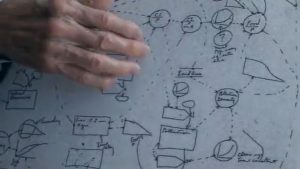1
To advocate for a new science of effective organization, Stafford Beer draws numerous parallels between economy and nature, and more specifically, institutional systems and natural systems. If nature works according to known dominant laws, such as the theory of Relativity and the Second Law of Thermodynamics (pp.19), which laws underpin economy and its institutions? Later on, he suggests that in societary systems, Ashby’s law of Requisite Variety (which is key in his theory of Cybernetics) is the equivalent of the law of gravity in the physical universe (pp.22). In fact, nature itself is operating on Ashby’s law: when left unobstructed, nature is able to reach variety equilibrium (pp.29). Tuned with the environmental anxiety of his time, Beer states that “the total problem of the environment [is a] huge aggregation of unmapped variety” (pp.37). Is this excess variety the inevitable result of human intervention? Which subsystems (nations, governments and their departments) generated such a “global mess”(p.35) within the global system?
The United Nations is an intergovernmental institution designed to coordinate this “global mess” and maintain the stability of the global system. Around the same time Beer is writing, the Club of Rome (a UN-supported think-tank comprised of computer scientists and cyberneticians) designed a highly complex model of the global system, run numerous simulations and computed catastrophic conclusions. From the Liberty Machine to the Doomsday machine?
More on the Club of Rome and the role of Cyberneticsc in the BBC documentary trilogy “All Watched Over By Machines of Loving Grace”(link) by Adam Curtis (See Part 2, after 27.40)
- Forrester: The wolrd as a system
2
Throughout his essay, Gordon Pask traces the changing relationship of rules to form and the role of the architect as the translator in-between. The “pure architecture” paradigm operated on rules that were primarily visual and permanent: architectural practice was merely the application of style and stability to form – and that was the chief role of the architect (p69). However, Pask’s new theory suggests that architects are system designers, primarily concerned with immaterial properties of the system (such as control, communication and evolution) (p71). To what extent is this a top-down versus a bottom-up approach? Pask describes environments that act as collaborators of the inhabitants (p.74), but in which ways is this dialogue still mediated through the total authority of the architect as the sole system designer?
3
The question of problem-solving as the moral duty of the architect overarches all three readings. Beer challenges the timeless demand of solutions to problems, suggesting that it stubbornly preserves the old state of things. Instead, he declares that “it is better to dissolve problems than to solve them” (Beer, 42). On the same page, Cedric Price believes “architecture should have little to do with problem-solving – rather, it should create desirable conditions and opportunities” (Price,92). The cybernetic theory of architecture is certainly not a solutionist one. However, Pask points out how unprecedented problems that couldn’t be solved with ‘pure architecture’ tools, triggered unique (albeit not unifying or universal) solutions that prepared the ground for a new kind of new architecture’ (Pask, 69). In what ways are problems an evolutionary tool then? Why did Beer and Price find problems irrelevant? Finally, in hindsight, what are the problems of the cybernetic theory of architecture itself?

